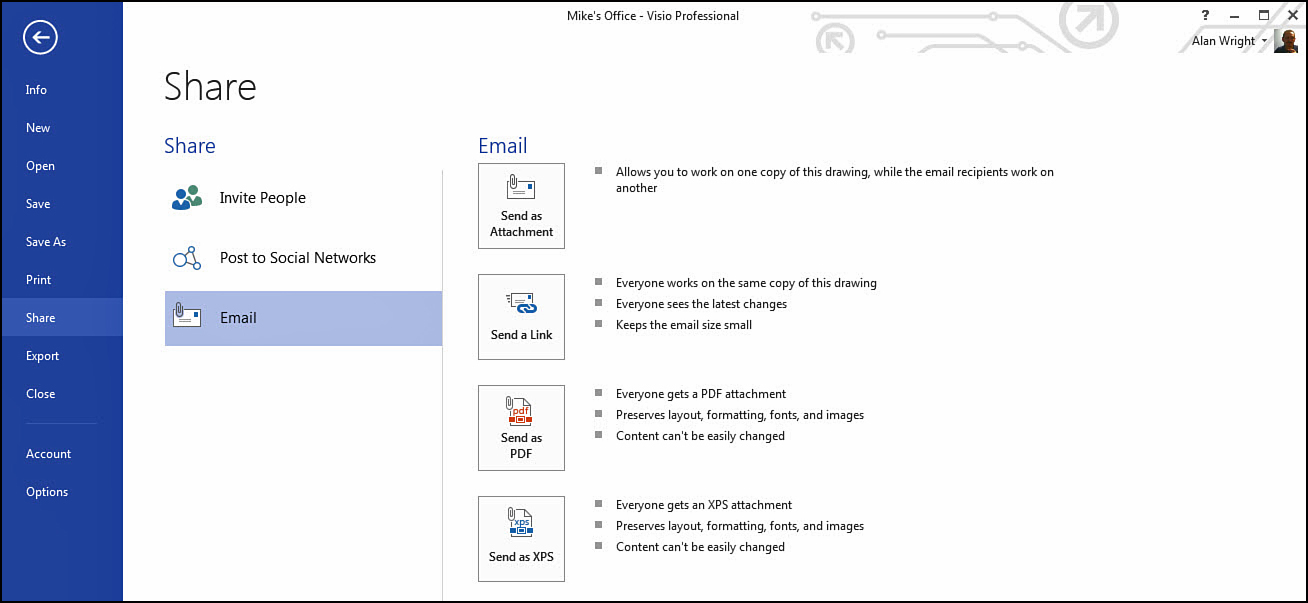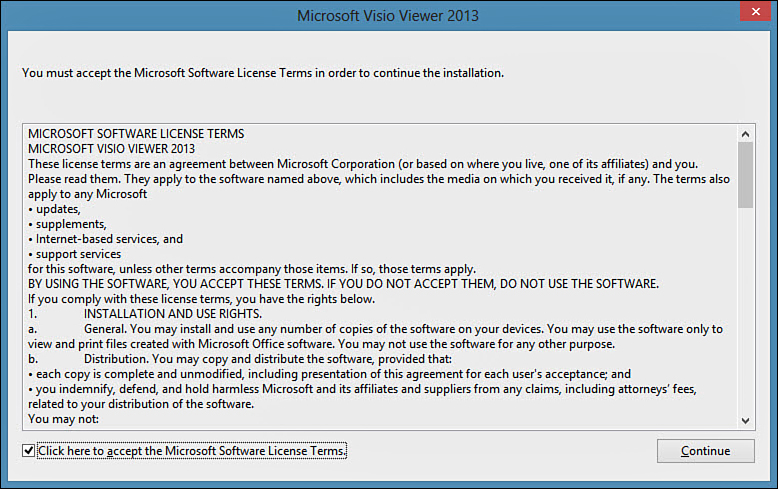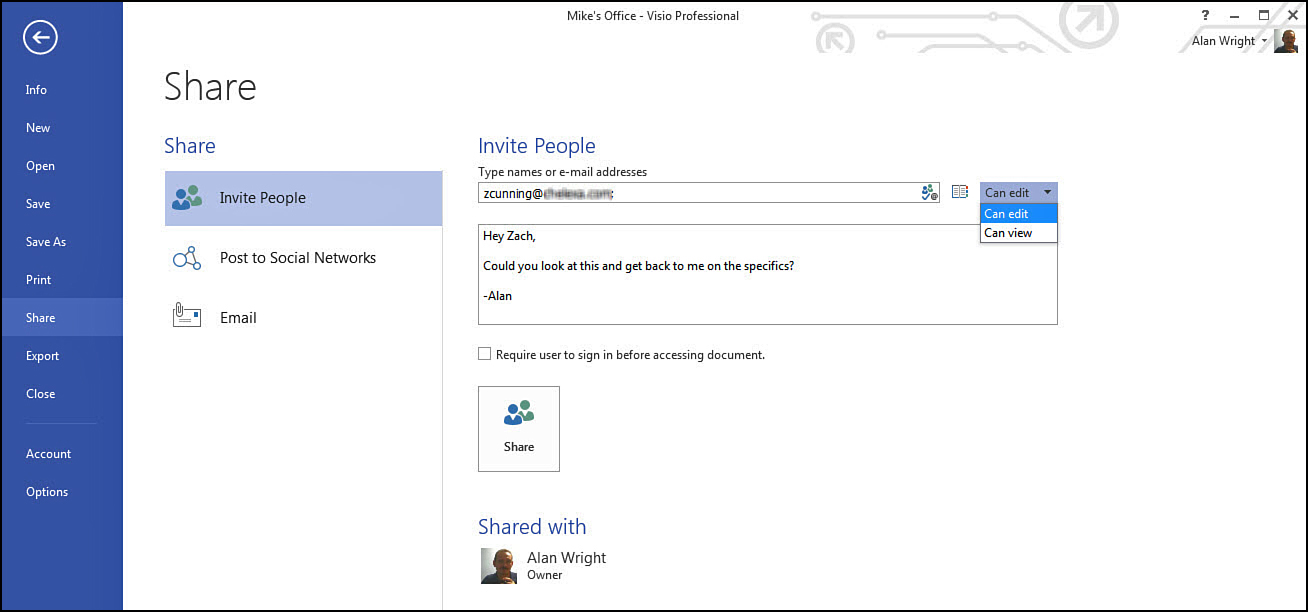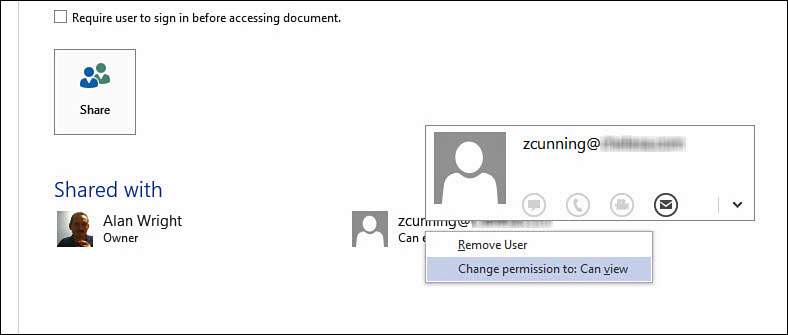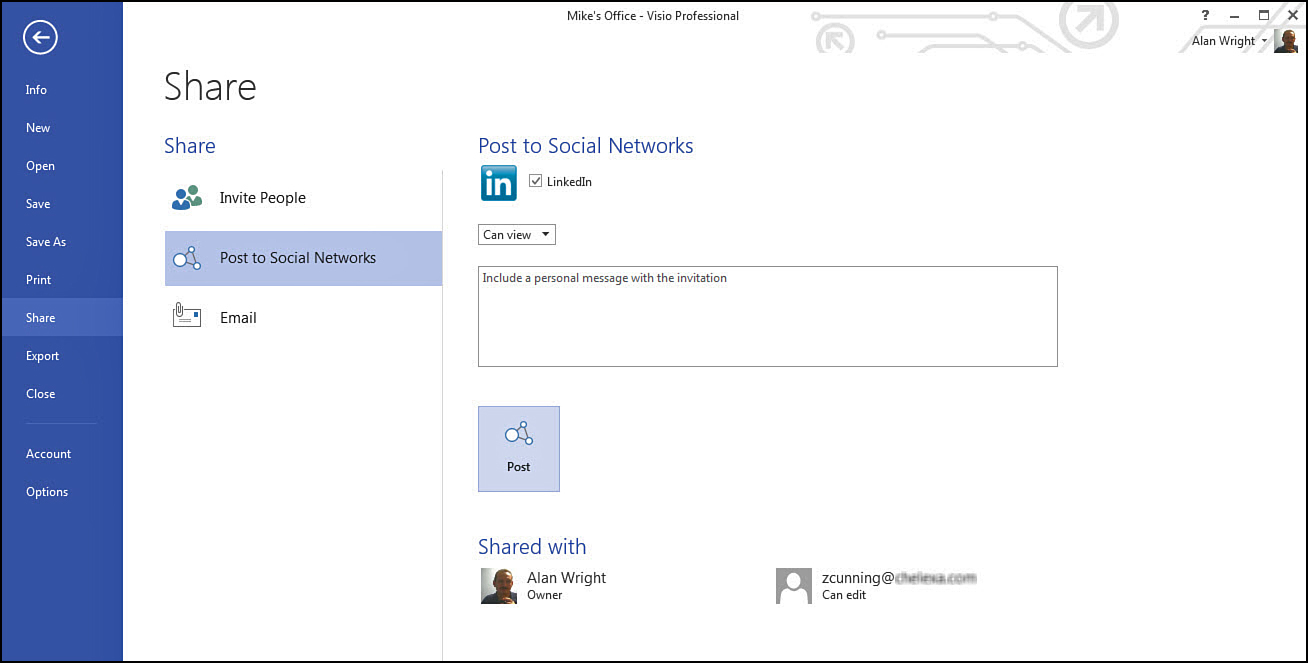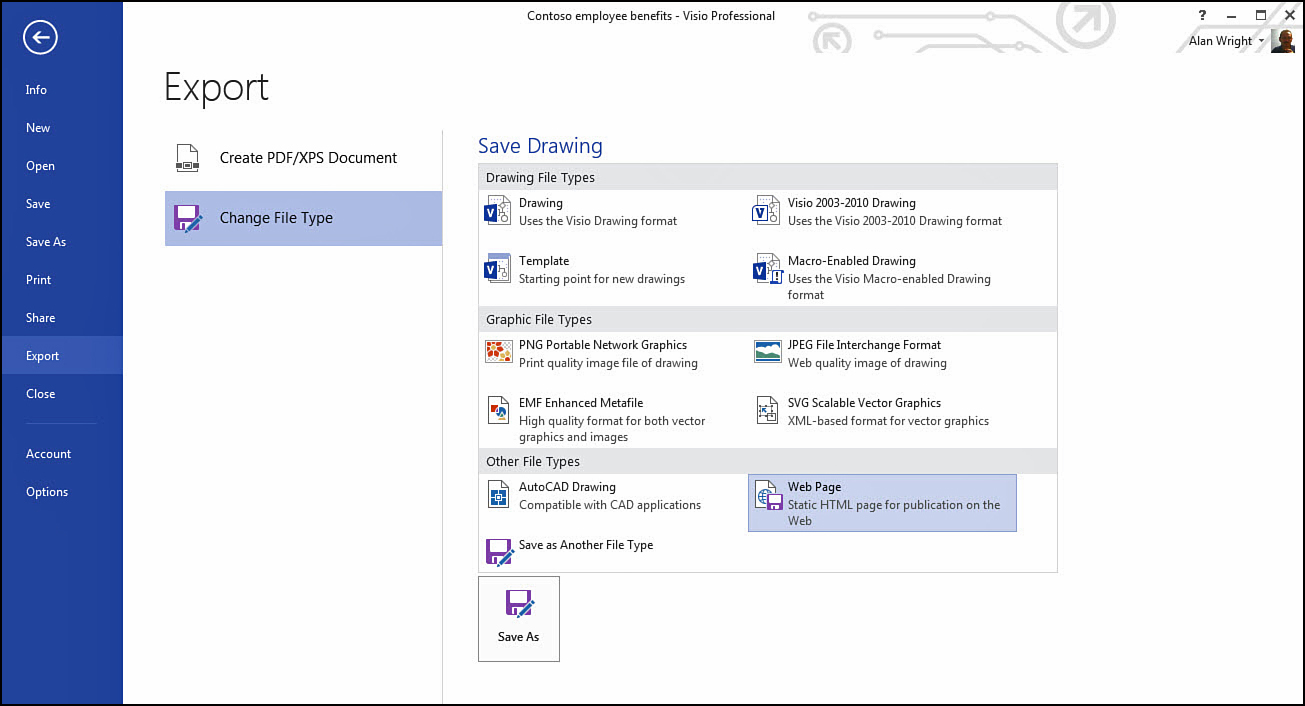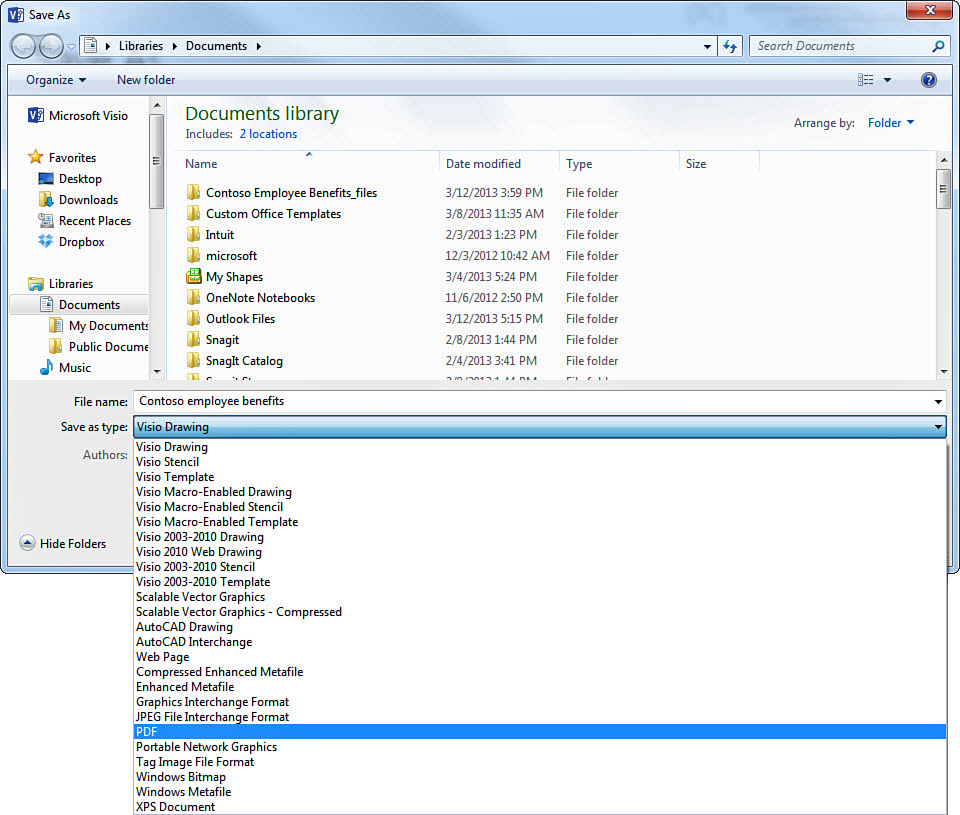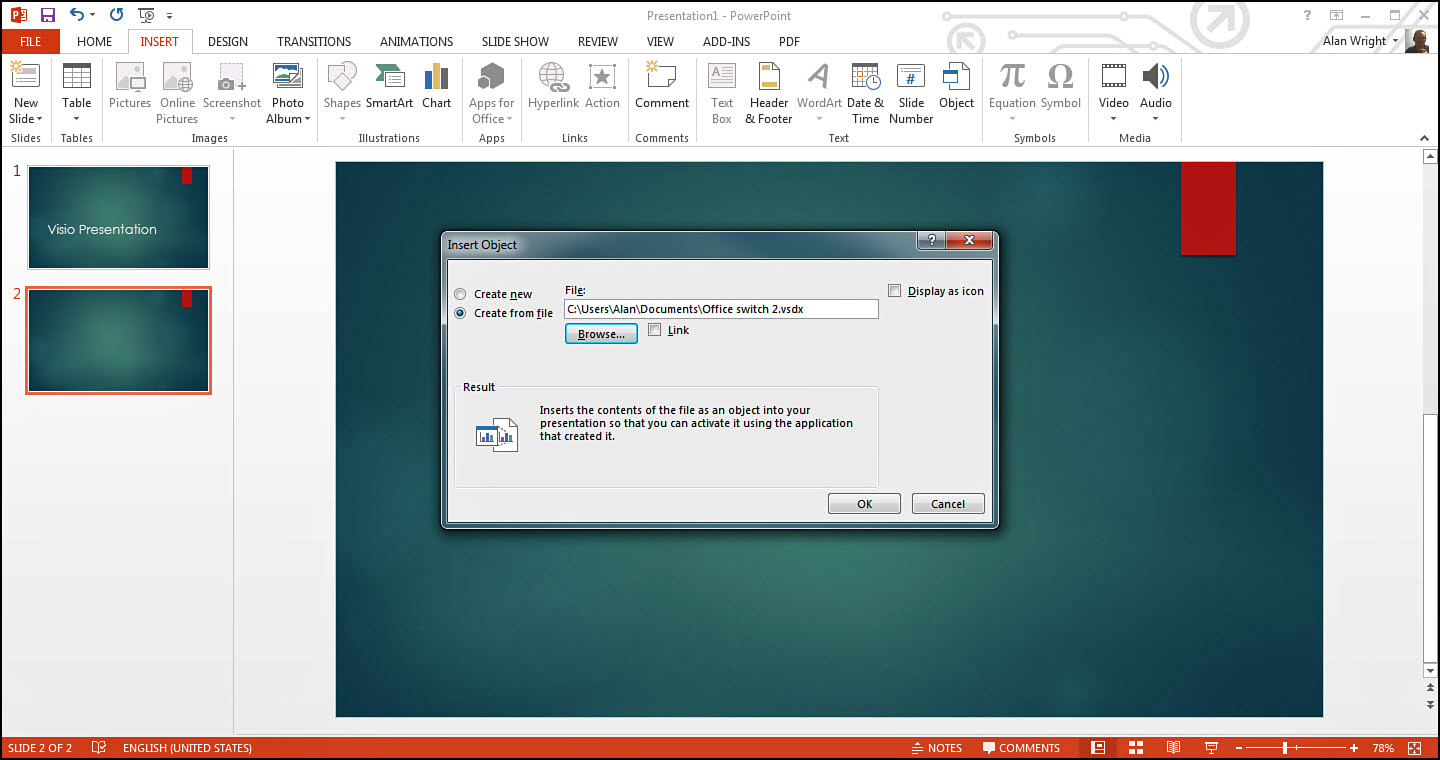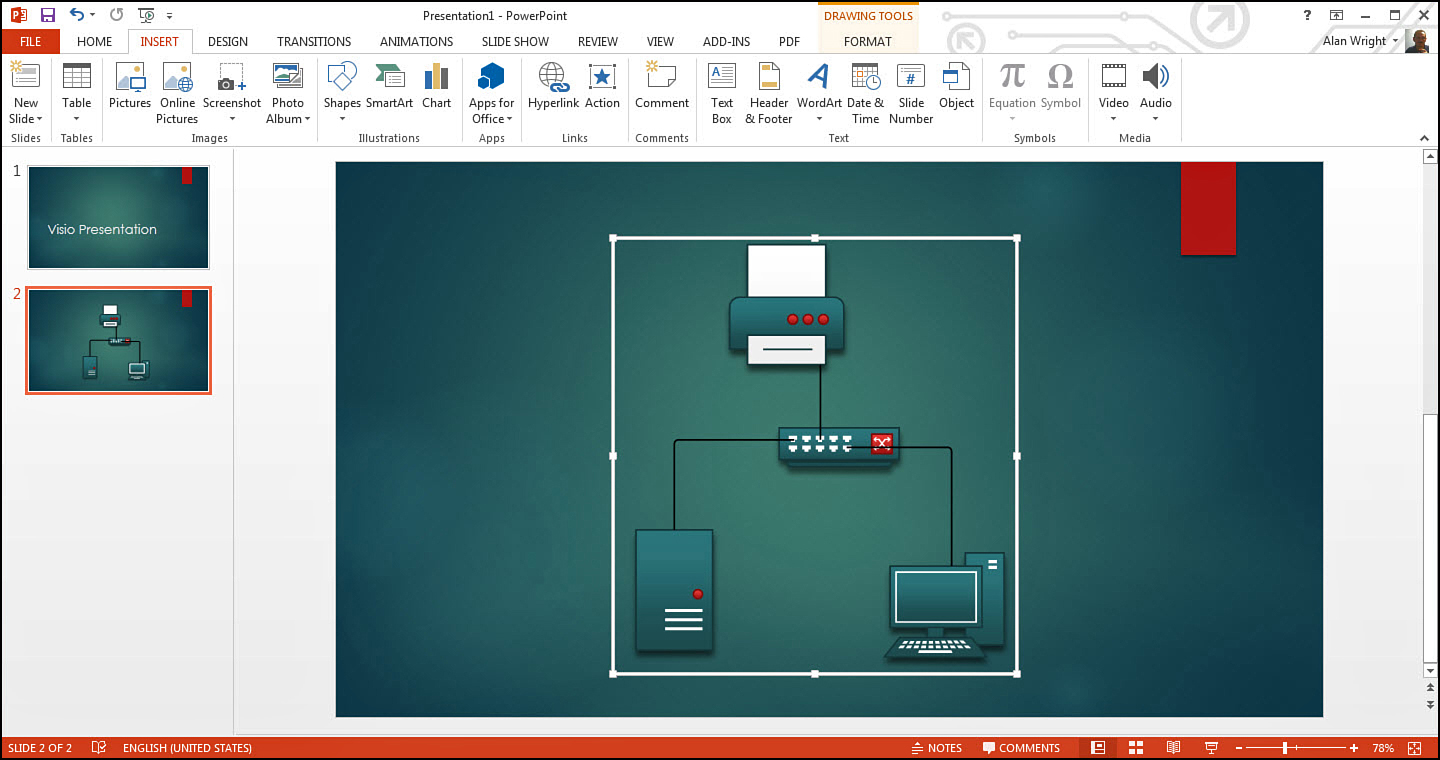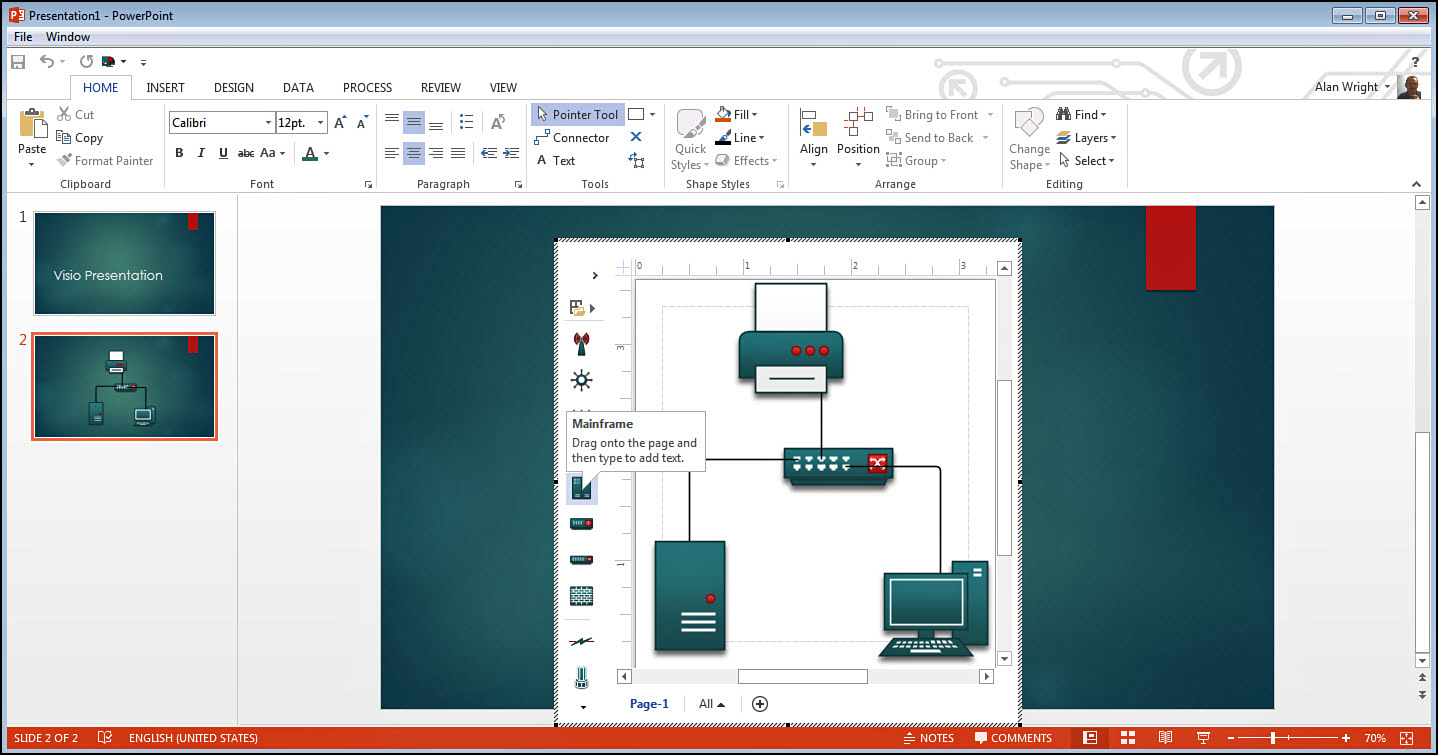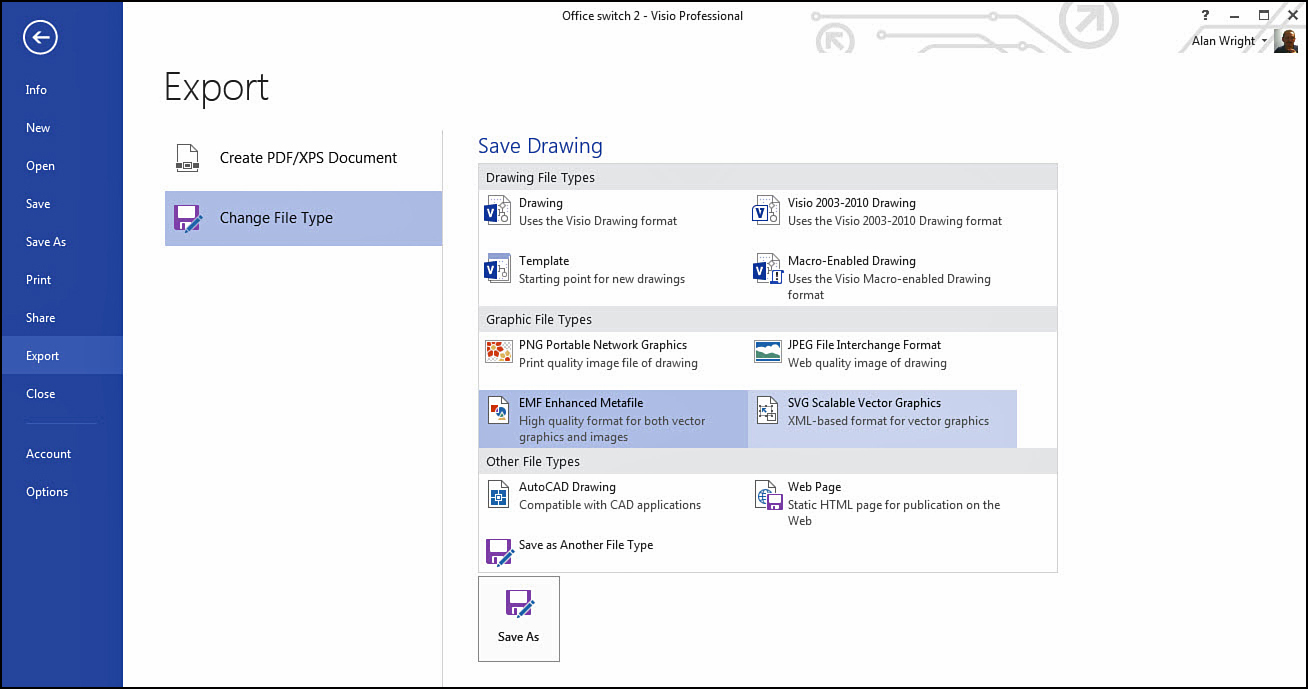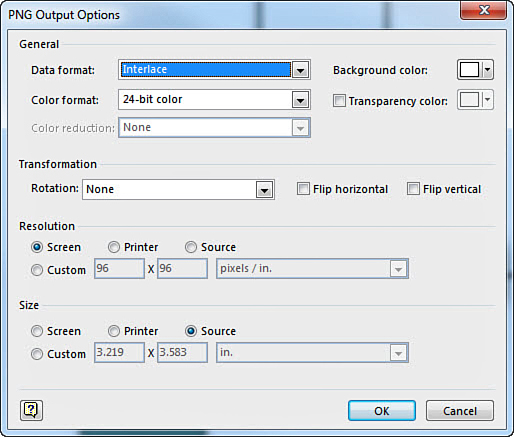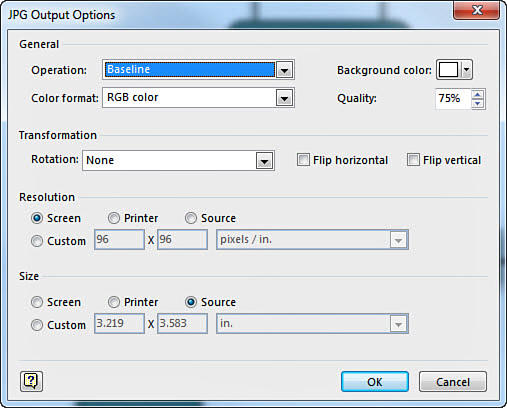12. Sharing Visio Diagrams
In This Chapter
• How can I email a Visio diagram?
• How does SkyDrive help me keep my drawings available?
• Getting your diagrams out on the interweb.
• Save your diagrams into other formats without jumping through hoops.
In the social world where we live, sharing has become a common part of our daily life. Whether it is a shared picture of someone’s Mexican dinner plate or a status update on a friend’s Facebook page, we have grown accustomed to sharing and being shared with. Visio provides lots of ways to share your work and even to make content that can be imported into other applications and media. This chapter considers how you can be a giver in sharing.
Share Drawings Using Email
I remember a person who would send me huge, bloated emails with PrintScrn screenshots that included the display from his multiple displays whenever he had a question. Although it is nice to see what others are seeing sometimes, this is not the most efficient way to share Visio drawings using email, especially if a drawing contains multiple pages.
Sharing your drawings in Visio is not only possible, but Visio gives you an intuitive interface to do so. After you create and save your drawing, you can open the File tab and select Share. Notice the options for Share: Invite People, Post to Social Networks, and Email. Select Email and you see the options displayed in Figure 12.1.
Four choices may be grayed out or enabled, depending on where you have saved your drawing:
• Send as Attachment opens a new email with your drawing attached as a VSDX document; the default subject line is the document name. Just add contacts to the To and CC fields and click Send. This is an independent copy, and any changes made after sending are not synced.
• Send a Link opens a new email with a link to your drawing; the default subject line is the document name.vsdx. Just add contacts to the To and CC fields and click Send. This link allows for the availability of a fresh, up-to-date copy.
• Send as PDF opens a new email with your drawing attached as a PDF document; the default subject line is the document name. Just add contacts to the To and CC fields and click Send.
• Send as XPS opens a new email with your drawing attached as an XPS document; the default subject line is the document name. Just add contacts to the To and CC fields and click Send.
 Note
Note
Sending a link does not mean that all recipients are able to open the drawing. It is common for corporate networks to restrict access to files located on a server to a minimum number of users. Permissions for some may be set to read-only access, which makes editing impossible. If you have questions about or trouble with a shared link to a file, consult with your network administrator to determine if permissions or rights need to be modified to access the drawing or if a different network location is recommended.
If your email recipients only need to see the drawing, consider sending it as a PDF or XPS formatted attachment. Both are common formats, and you can usually expect others to have the software needed to open and view. The format is preserved, and the recipient sees the drawing as it is meant to be seen.
If you need the recipient to make changes to or edit the drawing, a link or a copy of the VSDX file is the better choice.
Many email servers enforce size limits on attachments and may block the attachment from an email if it is too large. Also, sending large files to multiple individuals may be frowned upon in general because of the impact this has on network performance and email storage policies. Depending on the recipients and the reason for sending a copy, a link may be a better option.
Visio Viewer
Although it would be great if everyone had Visio, individuals and companies are forced to keep a close eye on resources and target Visio licenses to those persons who really need to work with Visio drawings on a regular basis. As a result, your generosity may put others into a difficult situation; if they don’t have the Visio software, they won’t be able to open a VSDX formatted file. Point them to Microsoft Visio Viewer 2013, a free application provided by Microsoft. Even if they have an older version, the newer version provides better results, and they need it for the new Visio file format. Search for the Viewer or use this link:
http://www.microsoft.com/en-us/download/details.aspx?id=35811
After downloading and running to install the Viewer, users must accept the Software License Terms and click Continue, as shown in Figure 12.2.
After installing Visio Viewer 2013, you are able to open Visio drawings and view them in Internet Explorer. You can navigate through tabbed pages, view comments, and selectively view layers. You can also select shapes and view shape properties. Visio Viewer installs to enable Visio files to be previewed in Windows Explorer and Outlook. Figure 12.3 shows how Visio Viewer is using Internet Explorer to show the drawing with the address bar and no tabbed ribbon interface.
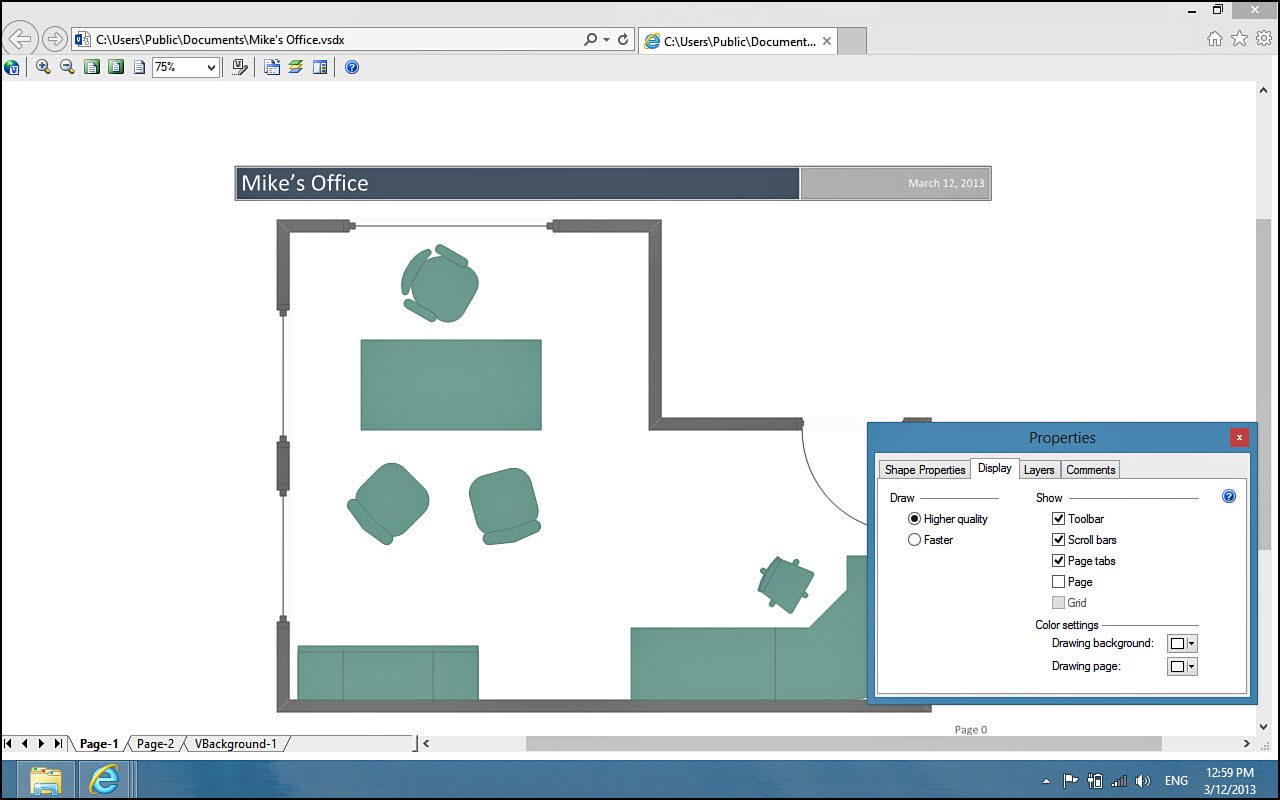
FIGURE 12.3 Visio Viewer 2013 allows you to see Visio drawings and inspect various elements of the drawing.
SkyDrive
A new standard feature in Office 2013 and Windows 8 products is the prominence given to the cloud-based SkyDrive. Visio is no exception to this, and you benefit from examining how this service facilitates sharing.
Make sure the drawing you open is saved to a SkyDrive location. From the File tab, select Share and then select Invite People. You are able to choose from your contacts and select the level of access they are granted, as shown in Figure 12.4. You can type a message to include with the link to the file saved in your SkyDrive. Select Share to send the invitation to your recipients.
In the lower section you see Shared With, which shows who currently has access to this file and the level of access granted. To modify this, right-click a name and you can change or remove access, as shown in Figure 12.5.
 Tip
Tip
SkyDrive allows you to easily share files with others; however, remember that SkyDrive allows you to access the same files from any computer or device with Internet access. As a result, you may find it useful to copy or save drawings and stencils to your SkyDrive for easy access from multiple computers you log in to.
Social Networks
Depending on where you have saved your drawing, you may see the option to Post to Social Networks included in the Share backstage area, as shown back in Figure 12.1 If you have added accounts from social network sites, you may be able to see options to post; if not, you are invited to add accounts to your LiveID, as shown in Figure 12.6.

FIGURE 12.6 You can associate other social network accounts to your LiveID to enable more share options.
When selecting Post to Social Networks, you are presented with the options to permit view or edit permission and include comments. You can select Post to send the drawing off to the indicated social network site (see Figure 12.7).
 Caution
Caution
Be very careful when using this feature. When information is posted to a social network site it can be difficult to undo. There may be corporate confidentiality or intellectual property policies to take into consideration. Also, depending on how you have allowed these sites to share information you have posted, it may available to more persons than you had intended.
Creating a Web Page from Your Diagram
A nice way to use Visio is in the design of web content. The process for a department to get an intranet website designed and working usually depends on a number of factors. Visio enables you to not only design a mockup of a website for layout and planning, you can go as far as publishing web pages.
Notice how a simple employee benefits page can be set up using standard shapes with hyperlinks added and a background applied in Figure 12.8.
When you are happy with the drawing, open the File tab and select Export, Change File Type, and Web Page (see Figure 12.9). This enables you to create a web page that can be saved locally or at a network location. The final result is shown in Figure 12.10.
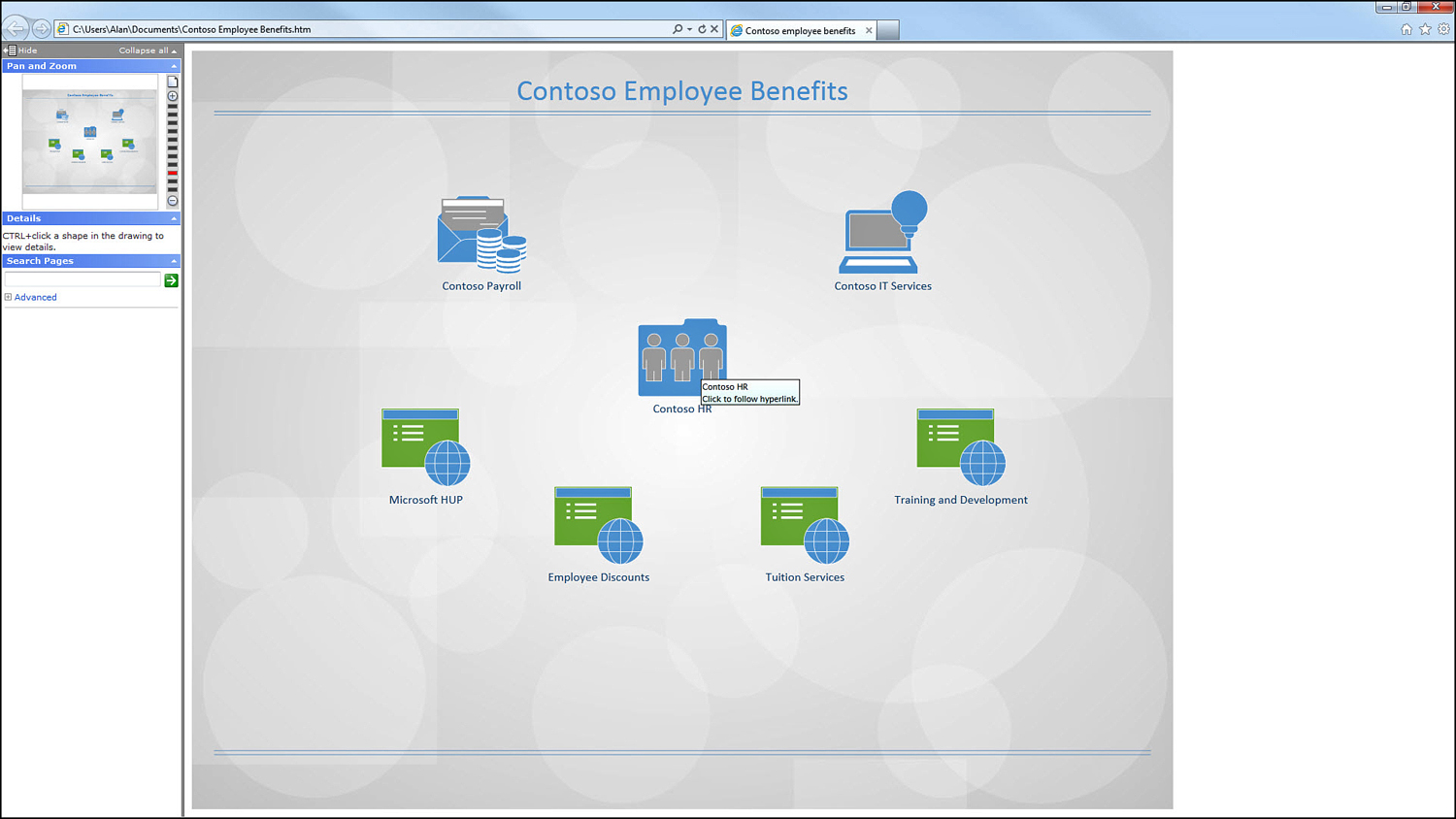
FIGURE 12.10 When Visio saves a web page, an instance opens automatically, allowing you to review the results.
Web pages created from Visio have vector-based images, which means that you have no degradation issues when zooming in. Some obstacles and limitations exist when using Visio as a web page publisher that make it unrealistic as a website design platform; however, if you need to design specific pages that include diagrams or simple links with high-quality graphics, take time to experiment with Visio web page and publish tools to determine if these meet your needs.
Saving to Other File Formats from Visio
Chapter 3, “Working with Basic Diagrams,” considered the importance of saving your diagrams, specifically using the new VSDX format. Although this default Visio drawing format is what you will likely use for day-to-day drawings, some situations might have you scrambling to save to a different format. This section considers some of the formats available and why you might use them.
Creating PDF and XPS Files
In Chapter 11, “Printing Visio Diagrams,” you considered the advantages of printing to PDF or XPS formats so as to test results and minimize paper and toner waste. There are also other valid reasons to use these formats.
In this chapter when you looked at Share options, Send as PDF and XPS were two of your options. These formats allow you to create static, easily viewable copies of your drawing that maintain the appearance and formatting you have painstakingly put together. You can email and archive PDF and XPS files and refer back to them if things have changed in the actual drawings. Text remains text, and each shape can maintain one usable hyperlink.
To save a drawing into one of these formats, open the File tab, select Save As, and choose a location. In the Save As window, choose the format from the Save As Type, as shown in Figure 12.11.
XML Formatted Drawings
As late as Visio 2010, it was possible to save a Visio drawing using an XML format. That is no longer possible with Visio 2013. Because VSDX is XML-based, it was decided that a separate XML save option would lead to confusion. Files previously saved as VDX (drawing), VSX (stencil), and VTX (template) can be opened by Visio 2013.
Older Visio Formats
It is not possible to save to the Visio 2002 format (or older) from Visio 2013. If you are working with persons who are using older versions of Visio, you can use Save As to save your work to a 2003–2010 drawing format (VSD), as shown in Figure 12.11.
To make the 2003–2010 your default save format, open the File tab, select Options, and in the Visio Options window select the Save tab. Here you can change the drop-down option Save Files in This Format from Visio Document to Visio 2003–2010 Document, as shown in Figure 12.12.
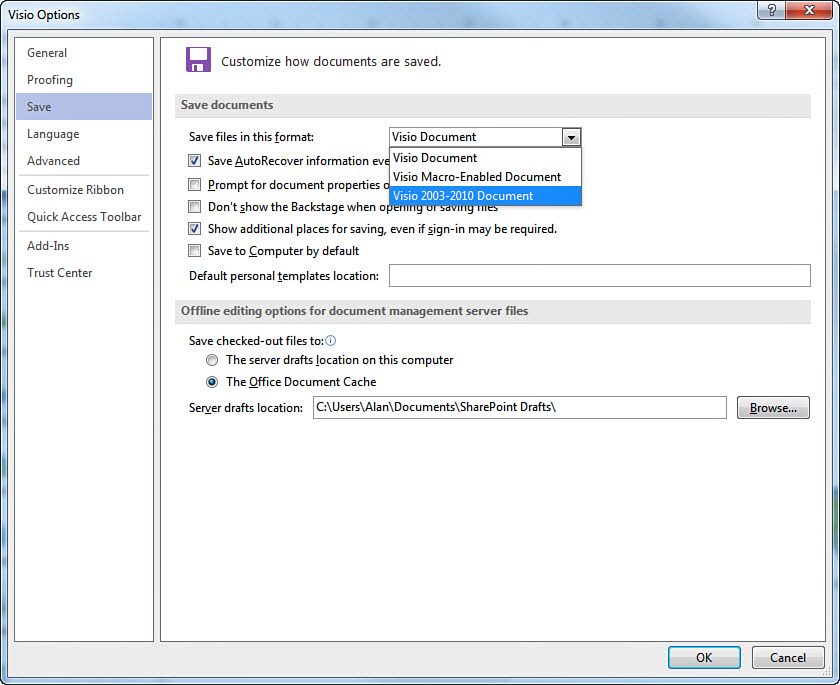
FIGURE 12.12 You can change the default save format if you regularly need to save work with the older VSD format.
Getting Visio Drawings into Other Applications
Visio provides the tools to make great visuals that can be used in websites, documents, presentations, and many other applications that you may work with. What is the best way to get your Visio content into these other forms of media? This section answer that question.
Office Applications
Visio is considered part of the Microsoft Office line of products; therefore, it shares the ribbon interface and many other common elements. This enables you to work with Visio content easily from other Office applications as long as Visio is installed on the same computer. Consider an example using PowerPoint 2013.
Notice in Figure 12.13 that you can insert an object into a PowerPoint slide. I have chosen a Visio drawing that I want to insert into the slide. In Figure 12.14 the diagram from Visio appears as one large selected object that I can move and resize.
From PowerPoint you can double-click the selected Visio object; you are presented with the familiar Visio tools and ribbon, as shown in Figure 12.15. From here you can add content or otherwise modify the Visio diagram from within PowerPoint.
 Note
Note
Even if Visio is closed, when you edit a Visio object from within another Office application the Visio.exe process is running in the background. There may be an initial pause or performance hit because of this, depending on your system.
Maintaining a Theme
Because Visio shares many common elements with other Office products, it should be no surprise that the new themes in Visio can be complemented in other Office products. In the examples shown in the previous section, both PowerPoint and Visio had the same Ion theme applied, which makes for a nice combination if you could see the figures in color. Besides Ion, the themes Integral, Slice, and Organic are others you can share in the 2013 Office themes.
→ To learn more about Themes, see page 72.
 Tip
Tip
If you want to match the theme used in an Office application but are unable to find the same theme in Visio, try using variants in both applications until you find a close combination. Office 2013 introduced many new themes, and although many are not exact matches to the new Visio themes, the variants allow for some close matches.
Other Applications
The easiest way to bring Visio content into other applications is to copy and paste. Because there are so many applications, it is impractical to describe all the ins and outs of using the Copy and Paste features effectively.
A general rule is that Paste inserts a graphical copy of the source. So a shape or diagram from Visio is a bitmap picture that you may be able to resize into the target application.
Many applications have a Paste Special option that may allow you to retain some of the properties from Visio. Experiment a bit and see if you are happy with the results.
Exporting Drawings to Image Formats
You have seen already how Visio allows you to export drawings and save them into other formats such as PDF or XPS. Notice in Figure 12.16 some of the other formats available in the Graphic File Types section. To get to this screen, select the File tab, then Export.
Common graphic output formats are the following:
• PNG—This format is often favored for websites and is similar to JPEG. You can assign a color to be transparent (see Figure 12.17). It is a raster format that prints well.
• JPEG—This has been a longtime standard raster format for photographs because it compresses the image into a small size with minimal loss of detail. It is also used for website images or graphics that are displayed on a screen.
• EMF—This format is vector based. It is favored for true color and quality printing.
• SVG—This XML format is a widely used, standard vector-based format.
Remember that raster-formatted images use a grid of pixels to re-create the image. Because of this they degrade when enlarged, becoming pixelated. Common image viewers open JPEG images easily; however, they might not recognize the PNG format as readily.
Vector-based graphics re-create images based on vectors that allow them to maintain sharp lines and colors. They are better suited for high-quality printing and play better with certain applications. If in doubt, consult the help section of the application you are using to see which format is recommended for importing graphics.

